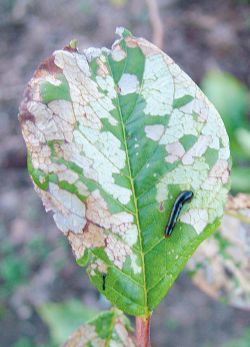Plant
Doctor Archive
Slugs
on plum tree
  WE
planted two plum trees last winter in our new garden. They took
a while to come into growth in the spring but then seemed to be
doing very well. However, the leaves now look like skeletons - all
the green flesh has been stripped away and on some there's a horrible
slimy bug that looks like a leech. What is it? WE
planted two plum trees last winter in our new garden. They took
a while to come into growth in the spring but then seemed to be
doing very well. However, the leaves now look like skeletons - all
the green flesh has been stripped away and on some there's a horrible
slimy bug that looks like a leech. What is it?
 YOUR
plum trees have been attacked by cherry slug (also called pear slug).
It's the larvae of a species of fly and feeds on the upper surface
of the leaves. When fully mature they drop off on to the ground,
burrow into the soil and pupate, eventually turning into the adult
fly which climbs out of the soil, flies off to mate, lays eggs and
starts the cycle over again. Usually two generations occur each
season, with the second causing the most damage in late summer. YOUR
plum trees have been attacked by cherry slug (also called pear slug).
It's the larvae of a species of fly and feeds on the upper surface
of the leaves. When fully mature they drop off on to the ground,
burrow into the soil and pupate, eventually turning into the adult
fly which climbs out of the soil, flies off to mate, lays eggs and
starts the cycle over again. Usually two generations occur each
season, with the second causing the most damage in late summer.
Apples, crab apples,
quinces, pears, cherries, plums and hawthorns can all be attacked.
If you do nothing, your plum trees will lose their leaves in autumn
and in spring produce healthy new growth, but they will probably
be reinfected next summer.
With older, larger trees
the damage is not always as noticeable and it can be hard to spray
them effectively. With your young trees you could help break the
pest cycle by dealing to them with a contact spray such as Nature's
Way Insect Spray, Mavrik, pyrethrum, neem oil or dusting with Derris
Dust. Make sure to apply it thoroughly so the spray comes in contact
with as many of the cherry slugs as possible. One good thing is
their feeding on the upper surface of the leaf makes them easy targets.
In spring, cultivate
under the affected trees by hoeing or forking to kill off pupae
which have overwintered in the soil. You may still get future infestations,
however, as the adult flies can travel long distances.
Weekend
Gardener, Issue 168, 2005, Page 24
Reproduced with permission from the former Weekend Gardener magazine. The views expressed here are not necessarily those of the RNZIH.
|
 |
 |
|